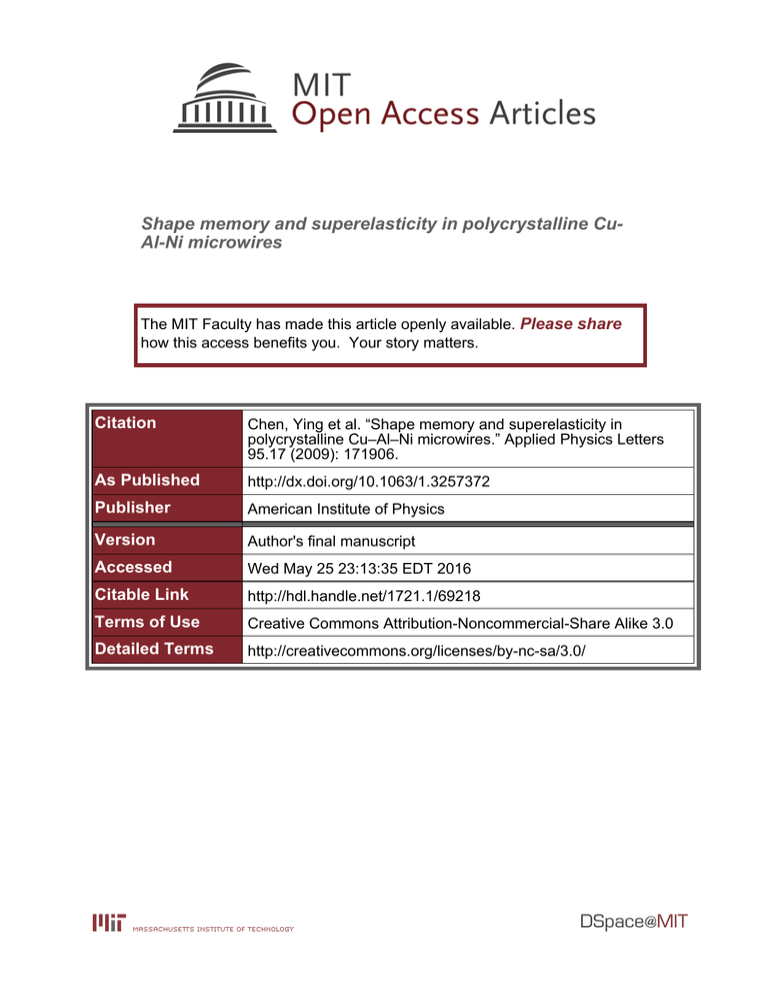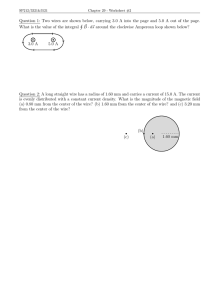Shape memory and superelasticity in polycrystalline Cu- Al-Ni microwires Please share
advertisement

Shape memory and superelasticity in polycrystalline CuAl-Ni microwires The MIT Faculty has made this article openly available. Please share how this access benefits you. Your story matters. Citation Chen, Ying et al. “Shape memory and superelasticity in polycrystalline Cu–Al–Ni microwires.” Applied Physics Letters 95.17 (2009): 171906. As Published http://dx.doi.org/10.1063/1.3257372 Publisher American Institute of Physics Version Author's final manuscript Accessed Wed May 25 23:13:35 EDT 2016 Citable Link http://hdl.handle.net/1721.1/69218 Terms of Use Creative Commons Attribution-Noncommercial-Share Alike 3.0 Detailed Terms http://creativecommons.org/licenses/by-nc-sa/3.0/ Shape memory and superelasticity in polycrystalline Cu-Al-Ni microwires 1 2 2 Ying Chen, Xuexi Zhang, David C. Dunand, and Christopher A. Schuh 1,a) 1 Department of Materials Science and Engineering, Massachusetts Institute of Technology, 77 Massachusetts Avenue, Cambridge, MA 02139, USA 2 Department of Materials Science and Engineering, Northwestern University, Evanston, IL 60208, USA We report a strategy to significantly improve the ductility and achieve large superelastic and shape memory strains in polycrystalline Cu-Al-Ni shape memory alloys that are normally brittle. We use a liquidphase (Taylor) wire forming process to obtain microwires of 10-150 µm diameter with a bamboo grain structure. The reduction of grain boundary area, removal of triple junctions, and introduction of a high specific surface area in the wire decrease constraints on the martensitic transformation, and permit both superelasticity and stress-assisted two-way shape memory with recoverable strains as high as 6.8%. a) Electronic mail: schuh@mit.edu. 1 Shape memory alloys (SMAs) are a unique class of multifunctional materials. They exhibit shape memory effects and superelasticity, which are both driven by the crystallographically reversible martensitic phase transformation. [1, 2] Copper-based SMAs, such as Cu-Al-Ni, have been intensively [3] studied in light of their low materials cost, but have not found wide technological usage. This is primarily [4-8] because most Cu-based SMAs are only sufficiently ductile for use in single crystalline forms; polycrystals of these SMAs are brittle and are prone to intergranular fracture during martensitic transformation. As a result, bulk polycrystalline Cu-based SMAs rarely exhibit large recoverable superelastic or shape memory strains. Here we describe an approach to overcome this problem by fabricating Cu-Al-Ni SMA microwires with a bamboo grain structure. These polycrystalline microwires effectively resist intergranular fracture because of their limited grain boundary area and lack of triple junctions (from the bamboo grain structure) and their high specific surface area (due to their small diameters). They exhibit cyclic superelasticity in tension, as well as stress-assisted two-way shape memory effects, both with very large recoverable strains, e.g., 6.8%, that have not been attained previously in bulk polycrystalline Cu-Al-Ni SMAs. We use a Cu-13.7Al-5Ni (wt%) alloy with a melting temperature of ~1100°C, and fabricate microwires by [9] the Taylor-wire drawing technique. Solid pieces of the alloy are placed in a closed-end borosilicate glass tube with 4 mm inner diameter and with a working temperature of ~1250°C. The tube and alloy are heated by an oxygen-acetylene flame to around 1200°C, where the softened glass tube is drawn down into a fine capillary (under low vacuum conditions inside the tube). The molten alloy inside solidifies rapidly into a metallic wire, whose diameter is primarily determined by the drawing speed; our Cu-Al-Ni SMA wires have diameters ranging from about 10 to 150 μm. Two typical wires are shown in Fig. 1, with diameters of (a) ~90 and (b) ~20 µm. We find that the Taylor-wire process is well-suited for producing continuous Cu-Al-Ni SMA wires of gauges comparable to and finer than those achieved by other methods. While solid-state wire drawing is limited by the alloys’ brittleness in polycrystalline bulk forms including continuous casting [11] and melt-spinning [12, 13] [10] , earlier efforts in liquid-phase processing, , produced significantly larger cross-sections (2 mm and 100-250 µm, respectively). The Taylor-wire technique yields finer wires of uniform diameter shielded from oxidation, and its versatility, efficiency and scalability are well established for other non-SMA [14-17] alloys. The Cu-Al-Ni alloy melt solidifies into the austenite phase just below the liquidus temperature, but may [3] subsequently undergo a eutectoid decomposition at ~500-600°C. To eliminate possible sub-eutectoid phases in the as-formed wires and achieve a fully austenitic condition, we anneal them in argon at 850 °C for one hour and then water quench. During annealing, grains are also expected to grow and form a bamboo grain structure due to the small diameters of the wires. Finally, the glass coating on the wires is 2 removed by immersion in a 10% hydrofluoric acid aqueous solution. Fig. 1 confirms that in the annealed wires, grain boundaries lie almost perpendicular to the wire axis. The resulting bamboo structure is desirable because, whereas the wires are still polycrystalline, any given cross-sectional slice of a wire can be thought of as a mostly unconstrained single crystal with high shape-memory or superelastic strain. Our Cu-Al-Ni SMA wires exhibit thermally-induced transformations between austenite and martensite as expected. Differential scanning calorimetry (DSC) was conducted at a heating/cooling rate of 8°C/min on a collection of two wires whose tensile testing data will be provided later in Figs. 2 and 3. The martensitic transformation in these wires occurs on cooling between 30°C (Ms) and 0°C (Mf), while the reverse transformation takes place on heating between 15°C (As) and 40°C (Af). These transformation temperatures are close to those reported for Cu-Al-Ni single crystals of the same alloy composition. [18] The enthalpies for the martensitic and reverse transformations are ~330 J/mol (5.7 J/g) and ~360 J/mol (6.2 J/g), respectively, which are consistent with prior values reported for similar alloys, e.g., ~389 J/mol by Otsuka et al. [5] and 267-362 J/mol by Gastien et al. [8] . We carry out isothermal uniaxial tensile tests of the SMA wires using a dynamic mechanical analyzer (TA Instruments Q800). Each end of the wire is mounted in an adhesive compound at the two gripping ends, which are clamped mechanically. No special surface preparation is conducted on the wires, which are tested with the as-prepared surface roughness seen in Fig. 1. The cross-head displacement is measured by a high resolution linear optical encoder within the testing instrument. Figs. 2(a) and 2(b) show the stress-strain curves for a single typical wire with ~110 μm diameter and ~6.3 mm gauge length, tested at 40 and 50°C, respectively. At each temperature, a uniaxial tensile force is applied at 0.2 N/min up to 1.1, 1.2, or 1.3 N (stresses of ~123, 134, and 145 MPa), before unloading at the same rate. Because the wire is austenitic at these temperatures, the strain accumulated during loading beyond the elastic regime is caused by the stress-induced martensitic transformation. As shown in Fig. 2(a), this strain almost completely recovers after unloading at 40°C, with the reverse transformation occurring all the way down to a condition of zero stress. This indicates that the austenite finish temperature of this wire is close to 40°C, consistent with the DSC measurement. At 50°C (Fig. 2(b)), the transformation strain recovers more completely upon unloading. The critical stress for inducing the martensitic transformation on loading has increased from ~17 MPa at 40°C to 52 MPa at 50°C, while that for the reverse transformation on unloading has increased from ~65 at 40°C to 100 MPa at 50°C. The resulting stress-temperature (Clausius-Clapeyron) slope is 3.5 MPa/K. By multiplying this value with the temperature 50°C (323K) and the total strain associated with the transformation, ~0.035, we obtain a stress-induced transformation enthalpy equivalent to ~300 J/mol (~5.2 J/g), in line with the DSC results. The present Cu-Al-Ni SMA microwire in Fig. 2 exhibits repeatable superelastic strains of a magnitude (from 2.9 to 4.3%) three to four times higher than bulk polycrystalline Cu-Al-Ni materials (which usually 3 achieve less than 1% without fracture). [12, 19] These large strains are achieved despite the fact that, with a gauge length over 6 mm, the wire comprises many dozens of individual grains. Shown in Fig. 3(a) are the stress-strain curves for another wire with ~90 μm diameter (and ~5.6 mm gauge length) tested for many cycles at 50°C. In each cycle, the load is increased at 0.1 N/min until 0.6, 0.7, or 0.8 N (~100, 118, and 135 MPa), and then decreased at the same rate. The curves for different cycles almost completely overlap in the transformation regime, indicating absence of damage. The superelastic recoverable strain for this wire is as large as ~6.8%. The same Cu-Al-Ni wire of 90 μm diameter is then “trained” by a scheme similar to that used by Wada and Liu [20] , i.e., by loading in the martensitic state and then heating to above the austenite finish temperature. While maintaining this constant load, the wire is then subjected to thermal cycling across the transformation temperature range, at 5°C/min far from transformation temperatures and 1°C/min close to and between them. The results obtained under 0.1 N (~16 MPa) and 0.2 N (~32 MPa) are shown in Fig. 3(b) in green and red, respectively. The wire elongates at low temperatures when in the martensitic phase and contracts at high temperatures when becoming austenitic. The transformation temperatures increase with the static applied stress, as expected from the Clapeyron relationship (although the true temperature of the wire might be slightly different from the measured temperature due to the thermal lag of the instrument). At both stresses, the wire exhibits the stress-assisted two-way shape memory effect: the strain caused by martensitic transformation during cooling is completely recovered by the reverse transformation during heating, and vice versa. The maximum strain is ~4–5%, which is again a very large recoverable shape memory strain not normally attainable in bulk polycrystalline Cu-Al-Ni SMAs. We attribute the large superelastic and shape memory strains seen in Figs. 2 and 3 to the specific geometry of our microwires. In a conventional bulk polycrystal, the martensitic transformation stresses in each grain must be accommodated at grain boundaries and triple junctions, often by cracking. In contrast, in the present microwires with a bamboo grain structure and small diameters, there are far fewer grain boundaries per unit volume and no triple junctions. Martensite plates can span across the wire cross[21-23] section, and most of the transformation stresses are relieved at the free surfaces; consequently the wires can undergo many cycles of martensitic transformation without fracture. Therefore, these Cu-Al-Ni SMA microwires may be suitable in various engineering applications where shape memory or supererlastic properties are required, either directly in the form of wire, or in more complex architectures comprising wires or fibers, e.g., fiber-reinforced composites, sintered wire mats or constructs, textile braids and fabrics. ACKNOWLEDGMENTS Y.C. and C.A.S. acknowledge the support of the US Army Research Office through the Institute for Soldier Nanotechnologies at MIT. X.X.Z. and D.C.D. acknowledge the support of the US National Science Foundation through grant DMR-805064 at NU (Dr. Alan Ardell monitor). 4 References [1] T. Tadaki, K. Otsuka, K. Shimizu, Annual Review of Materials Science 18, 25 (1988) [2] D. C. Lagoudas, Shape memory alloys: Modeling and engineering applications (Springer, 2008) [3] K. Otsuka, C. M. Wayman, Shape memory materials (Cambridge University Press, 1998) [4] K. Otsuka, C. M. Wayman, K. Nakai, H. Sakamoto, K. Shimizu, Acta Metallurgica 24, 207 (1976) [5] K. Otsuka, H. Sakamoto, K. Shimizu, Acta Metallurgica 27, 585 (1979) [6] H. Horikawa, S. Ichinose, K. Morii, S. Miyazaki, K. Otsuka, Metallurgical Transactions A 19, 915 (1988) [7] Z. Palánki, L. Daróczi, C. Lexcellent, D. L. Beke, Acta Materialia 55, 1823 (2007) [8] R. Gastien, C. E. Corbellani, M. Sade, F. C. Lovey, Scripta Materialia 50, 1103 (2004) [9] G. F. Taylor, Physical Review 23, 655 (1924) [10] G. Mussot-Hoinard, E. Patoor, A. Eberhardt, Materials Science and Engineering A 481, 538 (2008) [11] G. Motoyasu, M. Kaneko, S. H., A. McLean, Metallurgical and Materials Transactions A 32, 585 (2001) [12] P. Ochin, A. Dezellus, P. Plaindoux, J. Pons, P. Vermaut, R. Portier, E. Cesari, Acta Materialia 54, 1877 (2006) [13] S. Zeller, J. Gnauk, Materials Science and Engineering A 481, 562 (2008) [14] I. W. Donald, Journal of Materials Science 22, 2661 (1987) [15] K. Han, J. D. Embury, J. J. Petrovic, G. C. Weatherly, Acta Materialia 46, 4691 (1998) [16] G. Manfre, G. Servi, C. Ruffino, Journal of Materials Science 9, 74 (1974) [17] X. J. Zhang, Z. Y. Ma, Z. Y. Yuan, M. Su, Advanced Materials 20, 1310 (2008) [18] J. M. S. Juan, M. L. No, C. A. Schuh, Advanced Materials 20, 272 (2008) [19] K. Oishi, L. C. Brown, Metallurgical Transactions 2, 1971 (1971) [20] K. Wada, Y. Liu, Acta Materialia 56, 3266 (2008) [21] J. S. Juan, M. L. No, C. A. Schuh, Nature Nanotechnology 4, 415 (2009) [22] Y. Boonyongmaneerat, M. Chmielus, D. C. Dunand, P. Mullner, Physical Review Letters 99, 247201 (2007) [23] M. Chmielus, X. X. Zhang, C. Witherspoon, D. C. Dunand, P. Mullner, Nature Materials DOI:10.1038/nmat2527 (2009) 5 Figure Captions Figure 1. Scanning electron micrographs of two microwires showing bamboo grain structure, where grain boundaries are marked by arrows. Figure 2. (Color online) True stress-strain curves for a 110 μm Cu-Al-Ni wire at (a) 40 °C and (b) 50 °C. The blue, green, and red curves correspond to consecutive cycles at different maximum applied loads. Figure 3. (Color online) (a) True stress-strain curves for a 90 μm Cu-Al-Ni wire at 50 °C. The blue, green, and red curves correspond to consecutive cycles at increasing applied load levels. (b) Stress-assisted two-way shape memory effect of the same 90 μm wire revealed by thermal cycling under constant tensile load of 0.1 N (plotted in green) and 0.2 N (plotted in red). 6





